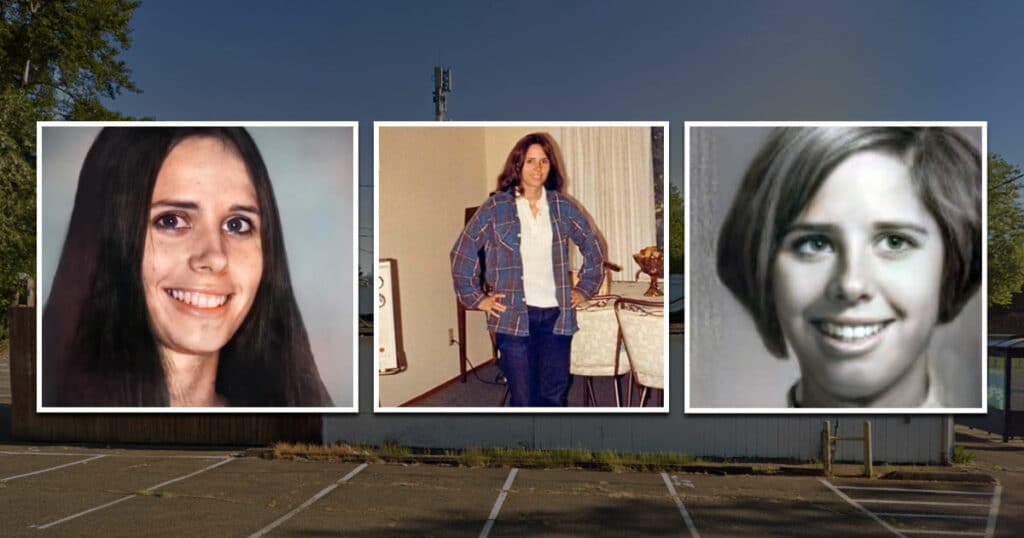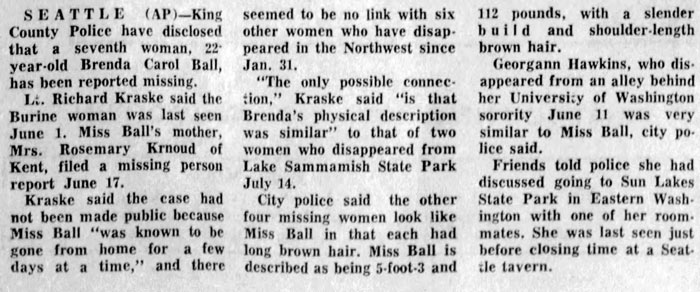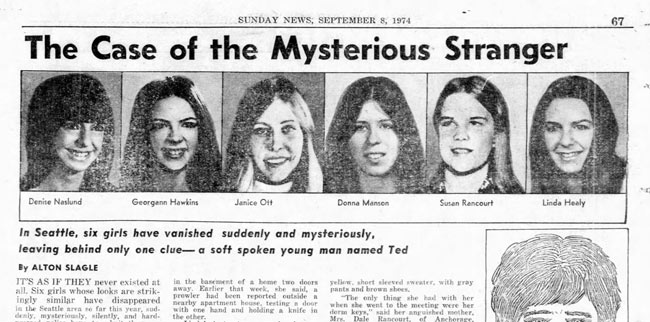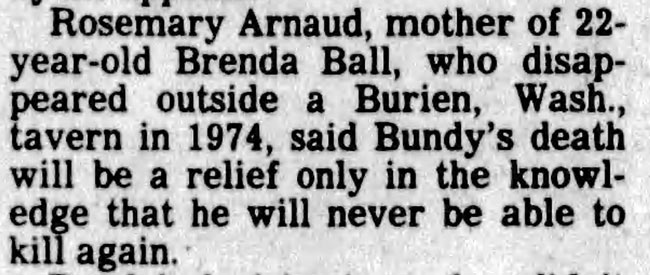In the early hours of June 1st, 1974, Ted Bundy abducted 22-year-old Brenda Carol Ball from the Flame Tavern in Burien, Washington.
Ten months later, two forestry students accidentally stumbled across her skull at a remote location on Taylor Mountain.

Brenda Ball was a 22-year-old who lived in Burien, Washington. She was 5 feet 3 and 112 lbs with brown hair. Two weeks before she went missing, she dropped out of Highline College in Des Moines. At the time of her murder, it seems as though she was at a crossroads in her life.
The disappearance of Brenda Carol Ball.
On the evening of May 31st, 1974, Brenda Carol Ball was drinking at the Flame Tavern in Burien.
Brenda was a regular at the bar. Because of this, she knew many of the patrons and staff members.

A Google Street View image of 12803 Ambaum Boulevard in Burien. This premises was once home to the Flame Tavern, a popular dive bar which had a reputation for being rough.
According to witness accounts, she stayed at the Flame Tavern until closing time, which was around 2 a.m.
As the night was coming to an end, Brenda asked a band member who she knew if he could give her a ride home. However, he said no because he was going in a different direction.
There are two conflicting reports about how Brenda left the bar that night. One report states that she left by herself and was planning on thumbing a lift. Another claims that she left with an unidentified man.
Although we will probably never find out exactly how she left the Flame Tavern, we do know that one thing is for certain. At some point in the early hours of June 1st, 1974, Brenda Carol Ball fell into the clutches of Ted Bundy.
When Brenda failed to return to her apartment in Normandy Park, there weren’t any immediate concerns about her safety. According to her roommates, she was an adventurous person who sometimes disappeared for days at a time.
Furthermore, the summer of 1974 had just arrived and the 22-year-old was now free of the responsibility of college. As a result, she was starting to party a lot.
After a while, her roommates started to realize that something was wrong.
As the days slowly turned into weeks, a sense of worry started to creep in. Although Brenda did have a habit of going on trips and staying with different people, this “excursion” of hers was beginning to stretch on for much longer than usual.
Not only had Brenda failed to make any contact, all of her clothes were still in the apartment.
In an attempt to ease their concerns, her roommates decided to contact her bank and ask if she had been withdrawing any money. When they learned that there was no recent activity on her account, alarm bells started to ring.
At that stage, they made contact with Brenda’s parents in Kent. Unfortunately, they hadn’t seen or heard from their daughter either.
It was now becoming clear to everyone that something was wrong.
Consequently, on June 17th, her mother Rosemary decided to contact the police and file a missing person report.
The police didn’t see a link between her and the other girls.
When Brenda Carol Ball first disappeared, the police did not believe that her case was related to the other missing girls.
Lynda Healy, Donna Gail Manson, Susan Rancourt and Roberta Kathleen Parks were all abducted from college campuses. Brenda, on the other hand, was slightly older and had vanished after spending the night at a dive bar.
To add to all of this, Ball had a history of leaving for days at a time.
According to King County detective Robert Keppel, there just didn’t seem to be anything in common.
Because of this, the authorities didn’t make her case public until August 7th.

In his statement to the media, Lt. Richard Kraske said that there seemed to be no link between Brenda’s case and the other women.
The police weren’t the only ones who were hesitant to connect the dots.
A search through newspaper archives reveals that the media took very little notice of Brenda Ball’s case.

The Sunday News published this article one month after Brenda’s case became public. The story did not mention her name.
Sadly, it seems as though she was largely forgotten about until two students happened across her skull on Taylor Mountain.
In an ironic twist of fate, it was Brenda’s skull that led investigators to the remains of some of the other missing girls.
Following the discovery, search teams combed the site and located Lynda Ann Healy, Susan Elaine Rancourt and Roberta Parks.
A staff member at the Flame Tavern claimed that they saw Brenda Ball speaking to a man with a sling.
One report claims that a staff member at the Flame Tavern saw Brenda speaking to a good-looking man who was wearing a sling on his arm.
This statement has continued to pique the interest of true crime authors over the years, as it is common knowledge that Ted Bundy liked to use fake injuries to lure unsuspecting victims back to his car.
However, there are a few question marks hanging over this story.
Firstly, it seems as though this statement was made at a later date.
If a staff member had reported this “sling story” at the beginning of the investigation, then it is likely that detectives would have immediately made the connection between Brenda’s disappearance and the other missing girls.
By August of 1974, the police were well aware that the man they were looking for was using a fake injury ruse.
Therefore, it stands to reason that any report of Brenda speaking to a handsome man in a sling would have stuck out like a sore thumb.
Secondly, no one else at the bar reported such a sighting.
Liz Kloepfer claims that Bundy was in a hurry on the evening before Ball went missing.
According to his ex-girlfriend Liz Kloepfer, Ted was in a “hurry” on the evening of May 31st.
The following is a transcript of one of her interviews.
It was a Saturday night, and my parents came out from Utah. The tradition in the Mormon faith is that when you’re eight years old, you get baptized.
And so I was going to have my daughter Molly baptized, and my father was going to do the baptism. We went out to dinner the night before, and Ted treated us all to pizza.
He was in a big hurry to go after we were done with pizza. The next day, he didn’t show up. He completely missed the baptism. He was probably two hours late.
And after it was all done, he showed up at the church. I forget what he said was the excuse. Car trouble or something like that.
I was mad because he was making me look bad in front of my parents. But, you know, never in our wildest dreams did we think he was out abducting people.
It is likely that Ted was eager to leave because he was planning on going out and hunting for another victim.
Furthermore, the fact that he was late the next day suggests that he was preoccupied with the disposal of Brenda Ball’s body. That or he needed to revisit her remains and confirm that he hadn’t left any physical evidence behind.
Bundy was usually drunk during his crimes. As a result, he often felt the need to revisit the scene and reassure himself that he hadn’t made any mistakes.
Because Liz’s mother kept a diary, there is a record of what happened on May 31st. That evening, Ted treated them all to food at a restaurant called Pizza & Pipes. However, the dinner only lasted for about an hour and a half.
Afterwards, Ted dropped them all off at Liz’s house and said that he was going home.
Bundy’s “confession” about Brenda Carol Ball.
During one of his prison interviews with author Stephen Michaud, Bundy “speculated” about what “might” have happened to Brenda Carol Ball.
According to Bundy, “the killer” may have intentionally changed his M.O. by picking up a hitchhiker.
At the time, the abductions of young women from college campuses were beginning to receive a lot of police and media attention.
In the killer’s mind, targeting a woman in a different setting might allow him to fly under the radar.
At some point, it seems as though he happened to come across Brenda Ball, who was looking for a ride home.
After picking Brenda up, Ted remained friendly and made small talk with her. When he learned that the young woman didn’t have any plans for the night, he asked her if she wanted to go to a party back at his place.
According to Bundy, she accepted this invitation.
The drive back to his place.
As they were driving back to his house, “the killer” continued to chat with Brenda.
During this journey, he had two goals: To remain focused and to keep her at ease.
In other words, he didn’t want his victim to have any second thoughts. Nor did he want to lose control of himself or become nervous by thinking about what he was planning on doing.
There was no party.
Once they reached his house, he made up an excuse about why there wasn’t a party.
Although Ball did express some hesitancy about the situation at first, it seems as though she was drunk and “bored” enough to go into the house and drink with the killer.
Bundy claims that the pair continued drinking together until she was ‘exceptionally intoxicated’. At that stage, they had a “consensual” sexual encounter.
However, this alone was not enough for the killer. According to Bundy, consensual sex did not completely fulfill his desires.
Subsequently, he decided to strangle the 22-year-old while she was sleeping.
There are doubts about this account of Brenda’s death.
If this story was a true account of what really happened, then it means that Bundy brought Brenda Carol Ball back to his rooming house in Seattle.

Between 1969 and 1974, Bundy lived in the Rogers Rooming House at 4143 12th Avenue in Seattle. According to his “confession”, he brought Brenda Carol Ball back to this residence in the early hours of June 1st, 1974.
This would have been a very risky move on his part, as there were other tenants living in the building.
Judging by his actions in other cases, Bundy was an impulsive creature who almost immediately attacked his victims as soon as he had the chance.
Therefore, this story about him remaining calm and driving 15 miles back to a place where other people knew him is pretty difficult to believe.
From Bundy’s standpoint, it would have been much easier to drive to a remote location and attack her. There were no benefits to bringing Brenda back to his room, only risks.
During the interview, Stephen Michaud was quick to point out that it seemed “terribly risky” for the killer to bring a victim back to his house.
Michaud: He’d take her home?
Bundy: Sure.
Michaud: It would seem terribly risky.
Bundy: If you live with someone. But he had his own house.
In reality, Bundy did not have his own house. Instead, he was renting a room in a house with other people. In other words, this wasn’t as “risk-free” as his confession suggested.
If his victim had screamed or made a noise while he was attempting to strangle her, then Bundy would have found himself in a very exposed position.
If Bundy strangled Brenda Carol Ball to death, then why did her skull have a large fracture?
When two forestry students discovered Brenda Ball’s cranium in 1975, a large portion of the right side of the skull was missing.
This suggests that she received an extremely heavy blow to the side of her head. According to the medical examiner, such a fracture was not the work of wild animals.
If Bundy was telling the truth about strangling Brenda to death, then it is difficult to see why he would have needed to inflict such a blunt force injury.
Phyllis Armstrong.
Former UW student Phyllis Armstrong stated that a man in crutches asked her to carry a gas can to his Volkswagen Bug on May 31st, 1974. Once they reached the car, he asked her to get inside and help him start it by pushing a button underneath the steering wheel.
However, by that stage, Phyllis was starting to feel that something was off about the situation. Consequently, she apologized and quickly left.
This encounter took place at 11 p.m., roughly three hours before Brenda Ball went missing. If the man in question was Ted Bundy, then it means that his statement about “the killer” purposely changing his M.O. in order to avoid attention was a lie.
In other words, Bundy didn’t change his M.O. as part of some cunning strategy to avoid detection. In reality, he changed his M.O. because his initial plan to abduct another college student had failed.
Bundy’s comment about purposely changing his modus operandi also makes little sense when you consider the fact that he abducted UW student Georgann Hawkins less than two weeks after Ball.
This wasn’t a real confession.
Doubts and inconsistencies aside, the main reason we cannot accept his story as the truth is because it wasn’t a real confession. Instead, it was a “conversation” about how the killer “may” have abducted Brenda Ball. Hence the reason Bundy spoke in third person.

In the days leading up to Bundy’s execution, Brenda’s mother Rosemary Arnaud said that his death will be a relief because it means that he will never be able to kill again.
Bundy was a liar.
Another overarching issue is the fact that Bundy was an egotistical liar who got off on toying with people, especially interviewers. He changed his statements on multiple occasions, depending on who he was talking to at the time. For example, he made several conflicting statements about who his first victim was.
He was also preoccupied with trying to convince others of his superior intelligence.
Because of this, it is possible that he created this story in order to flatter himself. In other words, he may have wanted people to believe that he had successfully gotten away with such a risky crime.
Conveniently, the crimes detailed in Bundy’s “confessions” were always a lot more daring and cunning when he knew that there were no witness accounts to contradict his story.